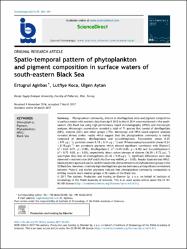| dc.contributor.author | Ağırbaş, Ertuğrul | |
| dc.contributor.author | Koca, Lütfiye | |
| dc.contributor.author | Aytan, Ülgen | |
| dc.date.accessioned | 2020-12-19T19:48:30Z | |
| dc.date.available | 2020-12-19T19:48:30Z | |
| dc.date.issued | 2017 | |
| dc.identifier.citation | Ağırbaş, E., Koca, L. & Aytan, Ü. (2017). Spatio-temporal pattern of phytoplankton and pigment composition in surface waters of south-eastern Black Sea. Oceanologia, 59(3), 283-299. https://doi.org/10.1016/j.oceano.2017.03.004 | en_US |
| dc.identifier.issn | 0078-3234 | |
| dc.identifier.issn | 2300-7370 | |
| dc.identifier.uri | https://doi.org/10.1016/j.oceano.2017.03.004 | |
| dc.identifier.uri | https://hdl.handle.net/11436/2094 | |
| dc.description | Agirbas, Ertugrul/0000-0001-7987-9668; Aytan, Ulgen/0000-0002-6530-3083 | en_US |
| dc.description | WOS: 000405241000008 | en_US |
| dc.description.abstract | Phytoplankton community, diatom to dinoflagellate ratio and pigment composition in surface waters with nutrient data from April 2013 to March 2014 were monitored in the southeastern (SE) Black Sea using high performance liquid chromatography (HPLC) and microscopic analyses. Microscopic examination revealed a total of 71 species that consist of dinoflagellate (58%), diatoms (25%) and other groups (17%). Microscopy and HPLC- based pigment analyses revealed almost similar results which suggest that the phytoplankton community is mainly composed of diatoms, dinoflagellates and coccolithophores. Fucoxanthin (mean 0.35 +/- 019 mu g L-1), peridinin (mean 0.18 +/- 0.14 mu g L-1) and 19- hexanoyloxyfucoxanthin (mean 0.24 +/- 0.15 mu g L-1) are prominent pigments which showed significant correlation with Diatom-C (r(2) = 0.63-0.71, p < 0.05), Dinoflagellate-C (r(2) = 0.49-0.80, p < 0.05) and Coccolithophore-C (r(2) = 0.72-0.82, p < 0.05), respectively. Mean carbon biomass of diatoms (36.50 perpendicular to 9.72 mg L-1) was higher than that of dinoflagellates (33.32 +/- 9.05 mu g L-1). Significant differences were also observed in nutrient ratio (N:P and Si:N) (One-way ANOVA, p < 0.05). Results illustrate that HPLC-based pigment approach can be used for taxonomic characterisation of phytoplankton groups in the SE Black Sea. Moreover, relatively high dinoflagellate species dominancy and significant correlations between Phyto-C and marker pigments indicate that phytoplankton community composition is shifting towards much smaller groups in SE coasts of the Black Sea. (C) 2017 the Authors. Production and hosting by Elsevier Sp. z o. o. on behalf of Institute of Oceanology of the Polish Academy of Sciences. | en_US |
| dc.description.sponsorship | Scientific Research Project council of Recep Tayyip Erdogan University [2013.103.01.02] | en_US |
| dc.description.sponsorship | We sincerely thank the officers and crew of R/V RIZE SUAR for their assistance during the cruises. Authors also thank to Dr. Serkan KORAL for HPLC analyses and Serkan SERDAR for nutrient analyses. This work was funded by Scientific Research Project council of Recep Tayyip Erdogan University (Project No: 2013.103.01.02). | en_US |
| dc.language.iso | eng | en_US |
| dc.publisher | Polish Acad Sciences Inst Oceanology | en_US |
| dc.rights | info:eu-repo/semantics/openAccess | en_US |
| dc.subject | Chlorophyll-a | en_US |
| dc.subject | Pigment | en_US |
| dc.subject | Phytoplankton | en_US |
| dc.subject | HPLC | en_US |
| dc.subject | Black Sea | en_US |
| dc.title | Spatio-temporal pattern of phytoplankton and pigment composition in surface waters of south-eastern Black Sea | en_US |
| dc.type | article | en_US |
| dc.contributor.department | RTEÜ, Su Ürünleri Fakültesi, Su Ürünleri Temel Bilimler Bölümü | en_US |
| dc.contributor.institutionauthor | Ağırbaş, Ertuğrul | |
| dc.contributor.institutionauthor | Koca, Lütfiye | |
| dc.contributor.institutionauthor | Aytan, Ülgen | |
| dc.identifier.doi | 10.1016/j.oceano.2017.03.004 | |
| dc.identifier.volume | 59 | en_US |
| dc.identifier.issue | 3 | en_US |
| dc.identifier.startpage | 283 | en_US |
| dc.identifier.endpage | 299 | en_US |
| dc.ri.edit | oa | en_US |
| dc.relation.journal | Oceanologia | en_US |
| dc.relation.publicationcategory | Makale - Uluslararası Hakemli Dergi - Kurum Öğretim Elemanı | en_US |


















